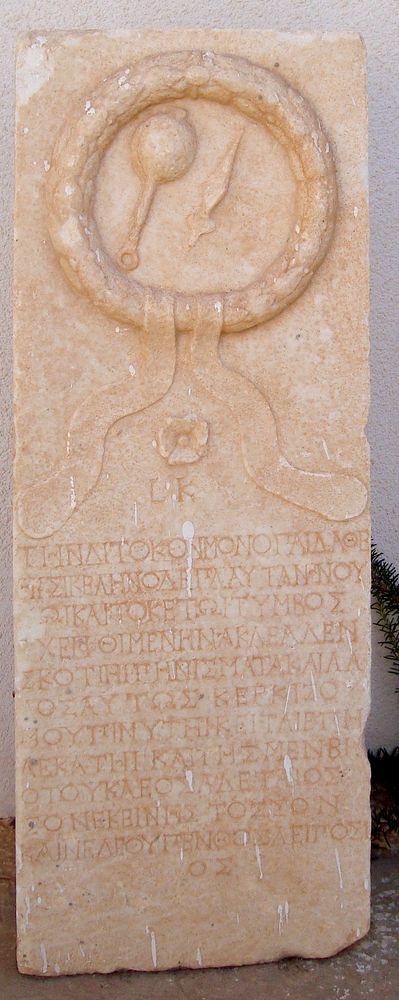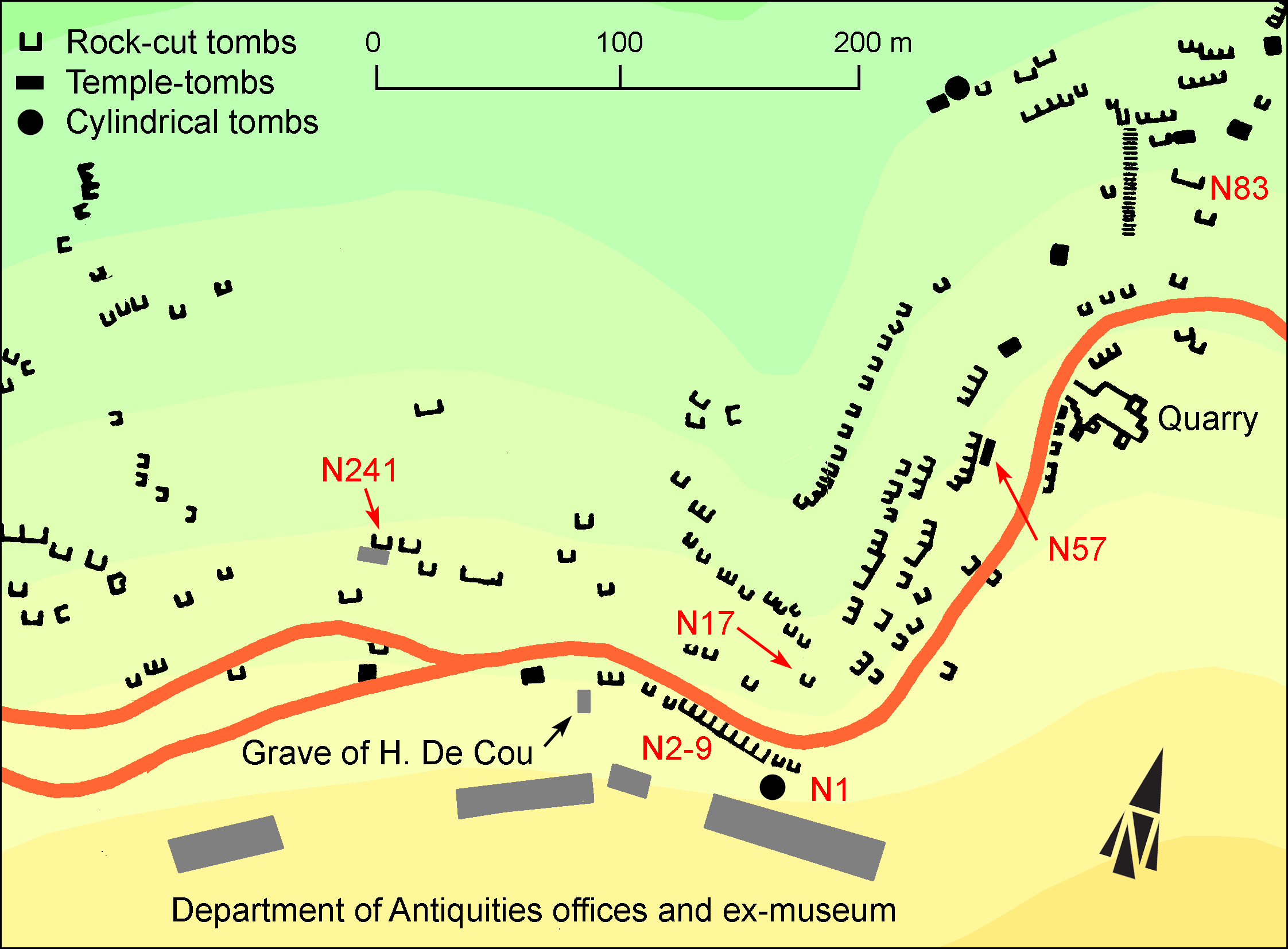EpiDoc XML:
GVCyr0122
Trismegistos ID:
105895
Source description
Support: Slightly tapering stele of white marble, reddish from earth; at top in relief
a large wreath with ribbons displayed at left and right below it; inside the wreath, a spindle and a roll with a ball of
wool on it; below the wreath, between the two ribbons, a rosette; on top, a small hole for attachment
(w: 0.355-0.41 × h: 1.07 × d: 0.18-0.22).
Layout: Inscribed a) just under the rosette; b) below the relief on 12 lines
(h: 0.61); the limits of verse-lines are evidenced either through a punct or through a space.
Letters: 0.025-0.03; traces of guidelines, slight serifs, letters packed together, nearly joining; straight alpha with dropped bar,
lower loop of beta larger than the upper one, some (but not all) circular letters smaller, pi with shorter right stroke, non-slanting
sigma, phi with two small loops on both sides of hasta, open omega with large 'feet'.
Date: Perhaps second half of first or first half of second century AD (lettering).
Findspot: Found by the Norton mission on March 22nd, 1911 at
Cyrene ➚:
North Necropolis before tomb N21 Cassels (see commentary).
Place of origin: Findspot.
Last recorded location: Cyrene Sculpture Museum, 247.
Seen by C. Dobias-Lalou in Shahat:
in 1979 in the older Sculpture Museum; in 2004 and again in 2010 in the forecourt of the
Cyrene Museum.
Text constituted from: Transcription from stone (CDL).
Bibliography
Robinson 1913, pp. 161-162, n. 11, fig. 10, also p. 504, whence Roussel, BE, 1914, p. 477; Sammelbuch 5873; Peek 1931, p. 317; GVCyr 012 ➚. Cf. Peek 1955, n. 758; Thorn – Thorn 2009, p. 30; Santucci – Uhlenbrock 2013, p. 16; Dobias-Lalou 2014, pp. 324-325.
Text
Interpretive
Τὴν διτόκον μονόπαιδα θε-
ῆις ἰκέλην ὅδε Πλαύταν · νού-
σωι καὶ τοκετῶι τύμβος
5ἔχει φθιμένην · ἀκλέα δ’ ἐν
σκοτίηι πηνίσματα καὶ λά-
λος αὔτως (vac. 1)· κερκὶς ὁ-
μοῦ πινυτῆι κεῖται ἐπ’ ἠ-
λεκάτηι (vac. 1)· καὶ τῆς μὲν βι-
10ότου κλέος ᾄδεται ὅσ-
σον ἐκείνης (vac. 1), τόσσον
καὶ μελέου πένθος ἀεὶ πόσι-
ος.
Metrical
| Τὴν διτόκον μονόπαιδα θε|ῆις ἰκέλην ὅδε Πλαύταν ·
νού|σωι καὶ τοκετῶι τύμβος | (5) ἔχει φθιμένην ·
ἀκλέα δ’ ἐν | σκοτίηι πηνίσματα καὶ λά|λος αὔτως (vac. 1)·
κερκὶς ὁ|μοῦ πινυτῆι κεῖται ἐπ’ ἠ|λεκάτηι (vac. 1)·
5 καὶ τῆς μὲν βι|(10)ότου κλέος ᾄδεται ὅσ|σον ἐκείνης (vac. 1),
τόσσον | καὶ μελέου πένθος ἀεὶ πόσι|ος.
Diplomatic
ΤΗΝΔΙΤΟΚΟΝΜΟΝΟΠΑΙΔΑΘΕ
ΗΙΣΙΚΕΛΗΝΟΔΕΠΛΑΥΤΑΝ · ΝΟΥ
ΣΩΙΚΑΙΤΟΚΕΤΩΙΤΥΜΒΟΣ
5ΕΧΕΙΦΘΙΜΕΝΗΝ · ΑΚΛΕΑΔΕΝ
ΣΚΟΤΙΗΙΠΗΝΙΣΜΑΤΑΚΑΙΛΑ
ΛΟΣΑΥΤΩΣ ΚΕΡΚΙΣΟ
ΜΟΥΠΙΝΥΤΗΙΚΕΙΤΑΙΕΠΗ
ΛΕΚΑΤΗΙ ΚΑΙΤΗΣΜΕΝΒΙ
10ΟΤΟΥΚΛΕΟΣΑΔΕΤΑΙΟΣ
ΣΟΝΕΚΕΙΝΗΣ ΤΟΣΣΟΝ
ΚΑΙΜΕΛΕΟΥΠΕΝΘΟΣΑΕΙΠΟΣΙ
ΟΣ
French translation
A l'âge de vingt ans
Ayant deux fois enfanté, mais mère d'un seul enfant, Plauta semblable aux déesses
est enfermée dans ce tertre, décédée de la maladie d'enfantement.
Dans l'ombre, sans gloire reposent avec elle la laine qu'elle fila et de la même manière sa babillante
navette repose près de son habile fuseau.
Et de sa vie on chante autant la gloire
que le deuil de son époux malheureux pour toujours.
English translation
Aged twenty years
Twice giving birth and once a mother, Plauta, equal to the goddesses
is shut up into this mound, deceased from the illness of childbirth.
In the shadow, deprived of glory, lie with her the spun wools, as well as the babbling
shuttle near the wise spindle.
And of her life the glory is so much celebrated
as the grief of her husband forever unfortunate.
Italian translation
Di anni 20.
Avendo partorito due volte e madre di un solo bambino, Plauta, eguale alle dee,
è racchiusa in questo sepolcro, morta di parto.
Nell'ombra, senza gloria, giace con lei la lana che filava, come pure la garrula
spoletta vicino all'abile fuso.
E della vita di costei la gloria è tanto celebrata
quanto il dolore del suo sposo per sempre infelice.




